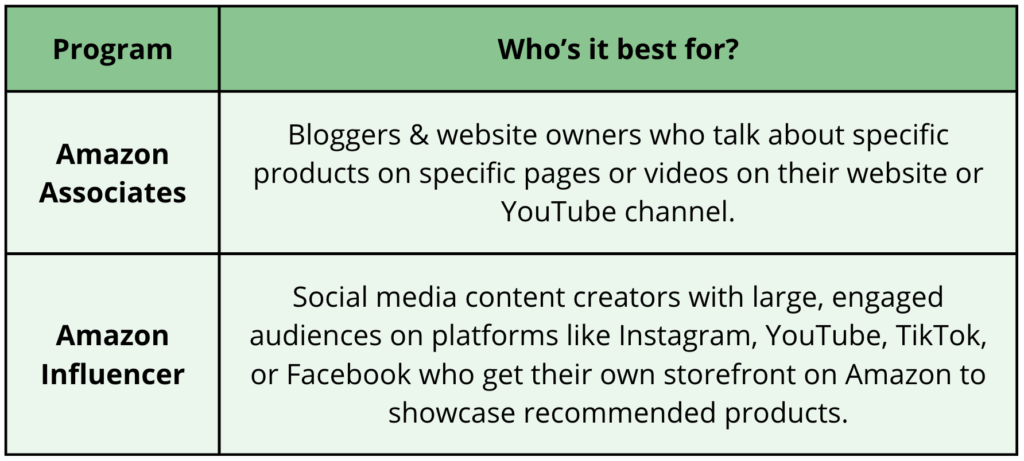I have been on the Amazon Associates Program since 2017 and joined the Influencer Program in 2023. The differences in these two programs is complicated and confusing… I know from experience!
Ultimately, there is one program that is better for you then the other, based on your unique situation. Let’s dive in so you know which one is best for you.

Quick Navigation
Amazon Associates Program: Ideal for Bloggers & Website Owners
What It Is : The Amazon Associates Program is designed for content creators who have a website, blog, or YouTube channel. It allows you to earn commissions by sharing affiliate links to Amazon products.
It’s best thought of as a program suited for content creators who talk about specific products on specific pages or videos.
There are no real requirements for joining the program. I signed up for the Amazon Associates Program on my first day of blogging, before I had any traffic at all.
Who It’s For:
- Bloggers with a content-rich website
- Website owners who want to monetize through affiliate marketing
- YouTube content creators
- Beginners in affiliate marketing
Key Benefits:
- Instant Approval for New Websites: No minimum traffic requirement. You can start as soon as your website is live with at least a few pieces of content.
- Access to Amazon’s “Site Stripe”: You can create direct affiliate links for any product listed on Amazon, allowing you to recommend specific products with precision.
- Multiple Monetization Avenues: Not only can you earn from product sales, but Amazon offers special commissions (bounties) for actions like sign-ups for Prime or registries.
- Global Reach: With Amazon’s OneLink, affiliates can monetize international traffic by geo-targeting users to their local Amazon marketplace.
How It Works:
- You apply with your website URL or YouTube channel.
- Once approved, you create custom affiliate links to products on Amazon.
- When someone makes a purchase through your link, you earn a commission (ranging from 1% to 10%, depending on the category).
Things to Keep in Mind:
- You need to make 3 qualifying sales in the first 180 days to keep your account active.
- Affiliate links can’t be shared offline (e.g., in emails, PDFs, or private messages). There has been some recent updates that allow you to share some links in emails, so make sure to look into the most up-to-date
Amazon Influencer Program: Perfect for Social Media Content Creators
What It Is: The Amazon Influencer Program is built for creators with large, engaged audiences on social media platforms like Instagram, YouTube, TikTok, or Facebook. Instead of sharing individual product links, influencers get their own custom storefront on Amazon to curate and showcase recommended products.
If you have a social account where people follow YOU, and tune in to all of your posts, then the Influencer Program is probably the right option for you.
Who It’s For:
- Social media influencers with strong followings and high engagement
- Creators who don’t own a website but are active on platforms like Instagram, YouTube, TikTok, etc.
- Those who want an easier way to manage and share product recommendations
Key Benefits:
- No Website Required: You only need a social media account with significant engagement and followers (around 1K–5K minimum with measurable daily engagement).
- Personalized Storefront: You can create a curated storefront where all your favorite or recommended products live in one place. This offers a more branded and cohesive experience for your followers.
- Flexible Sharing: Storefront links can be shared anywhere online or offline—emails, PDFs, newsletters, and more—giving you a broader range of promotion options.
- Shoppable Content: With features like Amazon Live and shoppable posts, you can create highly engaging experiences for your followers, making it easier for them to shop directly from your curated content.
How It Works:
- You apply by linking your social media accounts.
- If approved, Amazon gives you a unique storefront link that you can promote across all your platforms.
- You earn commissions when someone makes a purchase through your storefront.
Things to Keep in Mind:
- While storefront links are easier to share, you can’t create individual product links like in the Associates Program.
- You must maintain engagement on your social channels to avoid account dormancy, which can result in losing access to the program.
- Limited to one storefront per marketplace, so monetizing an international audience can be tricky.
Key Differences Between Amazon Associates and Amazon Influencer Programs
There are some major differences in the two programs on Amazon, which is what makes it so confusing! Look through this table to see the segmentation in the two.
| Aspect | Amazon Associates Program | Amazon Influencer Program |
|---|---|---|
| Platform Requirements | Requires a website, blog, or YouTube channel | Requires a social media account with good engagement |
| Linking Options | Direct links to specific products | Custom storefront with curated products |
| Offline Sharing | Not allowed | Allowed (PDFs, emails, etc.) |
| International Reach | Can monetize global traffic with OneLink | Only supports one storefront per region |
| Commission Structure | Same across both programs, ranges from 1%–10% | Same as Associates |
| Approval Process | Almost instant, especially for websites | More rigorous, based on follower count and engagement |
Application Process & Requirements
Both programs have different entry requirements, and it’s important to know them before applying:
- Amazon Associates Program: You only need a website or blog to get started. Even if you’re just beginning and have minimal traffic, you can still get approved. However, you must make 3 qualifying sales in the first 180 days to keep your account active.
- Amazon Influencer Program: The criteria are more specific. Although Amazon doesn’t disclose exact numbers, you typically need 1,000–5,000 engaged followers on platforms like Instagram, TikTok, Facebook or YouTube. Engagement, not just follower count, plays a big role in approval.
Realistic Earnings & Commission Structure
One question I get asked often is: How much can I really make? Let’s set some realistic expectations:
- Amazon Associates: Your earnings are based on traffic and conversion rates. Commissions range from 1% to 10%, with categories like luxury beauty products offering the highest percentages. If you’re driving traffic from a niche audience with buying intent, it’s possible to make $1,000+ a month within a year, like my friend Debbie who earns $5,000/month promoting home decor products.
- Amazon Influencer: As an influencer, commissions are the same as for affiliates, but earnings will depend heavily on your audience’s engagement with your Storefront. Some influencers make $500–$2,000 a month, while others who have high engagement can go beyond that. I personally made over $1,000 in my first month on the Amazon Influencer Program, and continue to make $2,000-$4,000 per month.
Disclosure & Compliance
Regardless of which program you choose, it’s essential to remain compliant with FTC guidelines and Amazon’s own policies:
- For Amazon Associates, you must include a clear disclosure like: “As an Amazon Associate, I earn from qualifying purchases.”
- For Amazon Influencers, you need to include something similar on your social profiles: “#AmazonInfluencer” or “I earn commissions on purchases through my Amazon Storefront.”
Failure to disclose these partnerships properly can not only get you kicked out of the programs but may also result in legal consequences.
Trust me, this isn’t just scare tactic. People get kicked out all the time without realizing they were making mistakes here. Pay attention to ALL of the rules… they are long and exhaustive, but abiding by them is part of the game.
Program Maintenance & Avoiding Termination
Both programs require you to stay active:
- Amazon Associates: After your first 3 sales, there’s no required minimum traffic, but if you don’t comply with Amazon’s strict policies (like no offline promotion), your account could be terminated. Also, always ensure your links are up-to-date to avoid losing commissions.
- Amazon Influencers: Influencers need to consistently drive traffic to their storefront. Amazon can remove inactive influencers from the program due to dormancy, so it’s important to maintain engagement.
In my experience, its not very likely you’ll get kicked out for low traffic and engagement. Its far more likely to get kicked out for breaking terms of service.
Challenges and Pitfalls to Avoid
Each program has its challenges:
- Amazon Associates: Cloaking or shortening links using third-party tools is strictly prohibited. Additionally, purchasing through your own links or getting friends and family to do so will get you kicked out of the program.
- Amazon Influencers: You can’t create direct links to specific products—only to your entire Storefront, which can sometimes limit product visibility.
Which One Should You Choose?
- Amazon Associates is perfect if you’re running a blog or website and want more control over the products you promote. The ability to generate direct links to specific products gives you flexibility in your content strategy.
- Amazon Influencer is ideal if your audience primarily interacts with you on social media. It simplifies the process by allowing you to direct people to a single storefront where they can browse all your recommendations at once.
Can You Do Both Associates and Influencer?
Yes! If you have both a blog and an active social media following, you can take advantage of both programs to maximize your earning potential. Use affiliate links in your blog posts and share your storefront on social platforms.
This is what I am. I have been an Amazon Associate since 2017, monetizing my blog and YouTube traffic. And then, in 2023, I joined the Influencer Program.

